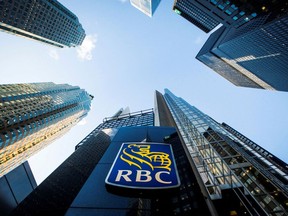Commercial real estate loans represent the second-largest lending exposure of Canada’s six largest banks
Article content
Canada’s banks may not be as exposed to commercial real estate as their counterparts in the United States, but that doesn’t mean their earnings aren’t at risk, particularly from the office segment pummelled by remote work, according to a prominent Bay Street analyst.
Advertisement 2
Article content
Commercial real estate loans represent the second-largest lending exposure of Canada’s six largest banks, trailing only residential real estate in proportional size, at around 10 per cent of lending portfolios, according to National Bank Financial analyst Gabriel Dechaine.
Article content
“Not only is the portfolio large, but it has also grown faster than the overall wholesale portfolio over the past seven years,” the analyst said in a note to clients on May 7. “Office exposures are particularly worrisome and represent 12 per cent of the average Big-Six CRE (commercial real estate) book.”
Rising interest rates have challenged commercial real estate owners and investors while, at the same time, remote work is leaving many office buildings under-utilized and hurting rent prospects.
Article content
Advertisement 3
Article content
Dechaine ran scenarios using the historical precedents of the 2008 financial crisis and the recession and real estate downturn in the early 1990s as proxies and concluded downside earnings per share risk could be in the high single digits or “well over” 20 per cent, though “likely at the lower end” of that range.
Office exposures are particularly worrisome
Gabriel Dechaine, analyst, National Bank
“Of course, in either scenario, earnings downside would be even greater considering that losses would also be incurred in other lending portfolios,” he said.
Despite the potential earnings impact, the analyst said none of the large banks would be likely to fall below the minimum capital cushions required by regulators.
Commercial real estate loans have attracted a lot of attention in the United States since the collapse of Silicon Valley Bank in March because, according to Goldman Sachs Group Inc. research, banks there with less than US$180 billion in assets hold around 70 per cent of commercial real estate loans in the banking system on their balance sheets. U.S. regional banks with between US$10 billion and US$20 billion in assets have 25 per cent of their loans tied to commercial real estate.
Advertisement 4
Article content
Dechaine said impaired commercial real estate loans aren’t rising substantially for Canadian banks yet, save for some exposure in the U.S. But he added that Canadian financial institutions do not disclose as much as their counterparts in the U.S. when it comes to set-aside provisions in their commercial real estate books, where U.S. banks have flagged provisions of two to three per cent.
“Despite the stellar (Canadian) credit metrics today, investors are undoubtedly questioning coverage ratios, in the event of an actual CRE downturn (particularly in the office category),” Dechaine said.
“With the CRE overhang and the ongoing turbulence in the U.S. regional banking sector that could trigger a recession, we believe most investors will maintain a cautious stance towards the Big 6 banks.”
Advertisement 5
Article content

Dechaine calculated that a trio of the financial institutions — Bank of Montreal, Toronto-Dominion Bank and National Bank — have roughly 10 per cent exposure to office real estate, while Royal Bank of Canada is at the top of the group with nearly 20 per cent.
Other market watchers have expressed less concern about the ability of Canadian banks to weather exposure to commercial real estate. In an April 5 column, CPA Canada chief economist David-Alexandre Brassard said the big banks were “well positioned” to deal with historically high vacancy rates and higher interest rates, noting that commercial real estate represents two per cent of their overall assets compared to 13 per cent for U.S. banks.
-

Why Canada’s office real estate sector is heading for a reckoning
-

Scuttled First Horizon deal leaves TD flush with capital
-

Crisis hits Canadian banks’ deposits in U.S.
“It’s the smaller banks that are at greater risk in this area, and there are very few in this country,” he said.
• Email: [email protected] | Twitter: BatPost


Comments
Postmedia is committed to maintaining a lively but civil forum for discussion and encourage all readers to share their views on our articles. Comments may take up to an hour for moderation before appearing on the site. We ask you to keep your comments relevant and respectful. We have enabled email notifications—you will now receive an email if you receive a reply to your comment, there is an update to a comment thread you follow or if a user you follow comments. Visit our Community Guidelines for more information and details on how to adjust your email settings.
Join the Conversation